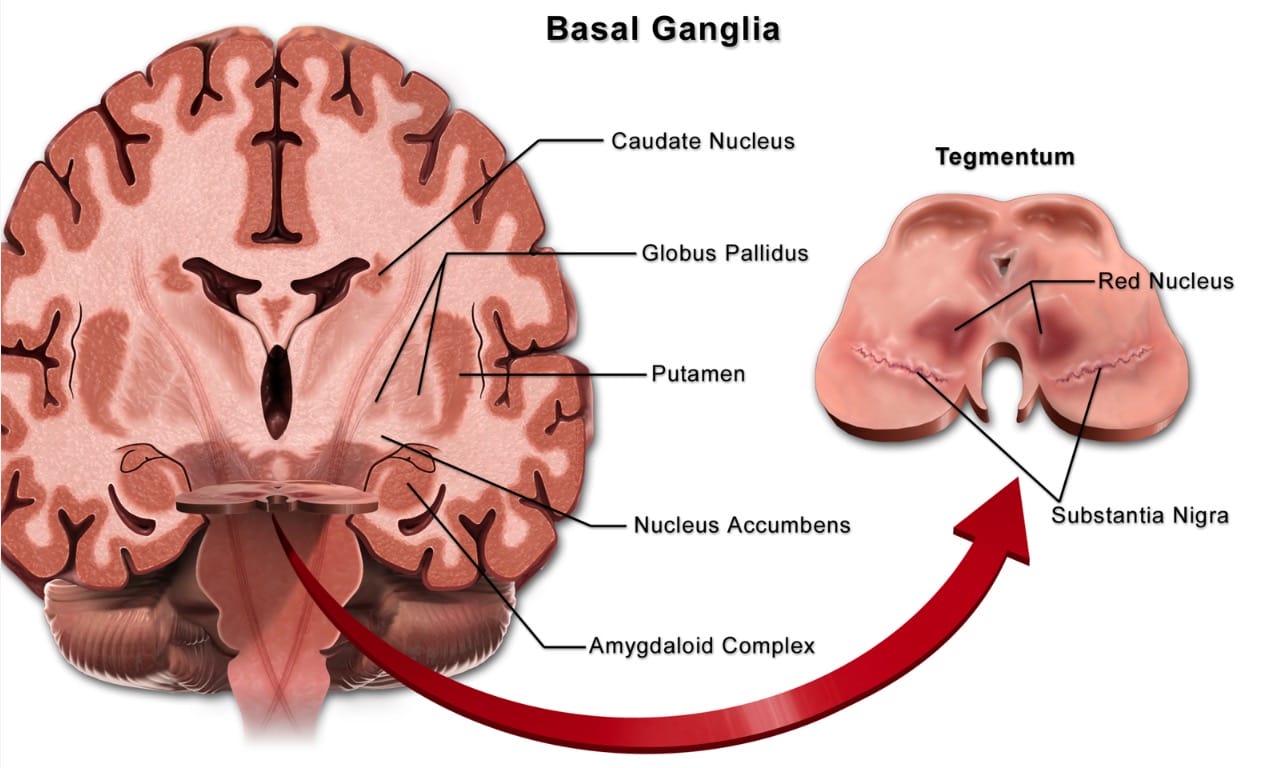Playlist
Show Playlist
Hide Playlist
Non-parkinsonian Movement Disorders: Other
-
Slides Non-parkinsonian Movement Disorders.pdf
-
Download Lecture Overview
00:01 Let's talk a little bit about Huntington's Disease-like syndromes. 00:05 These are family of inherited neurodegenerative diseases that closely resemble Huntington's disease. 00:11 So they're called Huntington's Disease-like. 00:13 And they resemble Huntington's disease and that they typically produce a combination of chorea, cognitive decline and dementia with behavioral or psychiatric problems. 00:24 Therefore, HDL syndromes: HDL 1, 2, 3 and 4. 00:28 When we think about them, we can divide them into HDL 1, 2 and 4 which are autosomal dominant. 00:33 They begin in early to mid adulthood and have clinical manifestations that are similar to Huntington's disease. 00:39 HDL 3 is autosomal recessive, often begins in childhood and patients have declined in thinking ability, cognitive dysfunction, difficulties with movement, speech disorders, and seizures in this condition. 00:51 Let's talk briefly about Dentatorubral-pallidoluysian Atrophy or just DRPLA. 00:57 This is a progressive brain disorder that causes involuntary movements, mental and emotional problems and a decline in thinking so symptoms very similar to what we see in Huntington's disease. 01:08 It is a genetic condition, it's inherited and an autosomal dominant fashion. 01:12 The signs and symptoms we see often differ between affected children and adults And patients who have onset before the age of 20, we see myoclonus, seizures, behavioral changes and ataxia, and that presence of seizures should prompt a workup for DRPLA. 01:29 In patients with onset of the condition after 20, we see prominent ataxia, choreoathetosis, delusions, and deterioration of intellectual functions that looks very similar to Huntington's disease. 01:42 What about drug induced-chorea? This may be an acute phenomenon or a consequence of long term therapy and there are a number of drugs that we think about. 01:50 All of those drugs increase dopamine levels within the brain. 01:55 Dopamine agonist can result in drug-induced chorea, levodopa can result in drug-induced chorea. 02:00 We use these for Parkinson's disease. 02:02 And the late in the setting of Parkinson's disease, we can see patients developing dyskinesias or extra movements that resemble chorea and are a complication of peak dose effects and that kind of on-off phenomenon that we see with Parkinson's disease. 02:17 We can also see drug-induced chorea with anticonvulsant medications benzodiazepines, anticonvulsants, and CNS stimulants. 02:26 Importantly, tardive dyskinesia is a subtype of chorea. 02:30 It's a specific chorea that occurs after a selected number of drugs. 02:36 When onset of chorea is after exposure to dopamine agonists, we call it tardive dyskinesia. 02:42 And often patients with tardive dyskinesia have prominent oral-buccal-lingual dyskinesias as an extra movements. 02:48 These patients develop involuntary chorea movements that typically affect the mouth tongue, causing random and stereotyped tongue protrusion and facial grimacing that becomes quite debilitating. 03:03 How do we treat chorea? Well, this depends on the type and the cause and the associated disease. 03:09 If the Korea is mild and doesn't interfere with the patient's daily activities, we may not need to consider treatment. 03:15 In more severe cases we consider pharmacologic therapy. 03:19 Tetrabenazine and reserpine can be used as well as antipsychotics like haloperidol and others. 03:26 And then in some cases, we will consider deep brain stimulation. 03:31 And then let's talk about paroxysmal dyskinesias. 03:34 These are dyskinesias, there's extra movements, it's a movement disorder that are paroxysmal. 03:38 They come and go. 03:40 And that fluctuation is very different from what we see in many of the neurodegenerative conditions. 03:45 These are episodic movement disorders in which there's abnormal movements that are present only during the acute attacks. 03:52 And there are three forms. 03:53 The first is paroxysmal kinesigenic dyskinesia. 03:57 These are brief involuntary hypokinesia such as chorea, ballismus, athetosis, dystonia, that's triggered by sudden movements so it's kinesigenic. 04:07 The sudden movement initiates this dyskinetic phenomenon. 04:12 There's paroxysmal non-kinesigenic dyskinesias. 04:16 These are attacks, they occur in episodes of dystonic or choreoathetonic movements precipitated by stress, fatigue, coffee, alcohol, or menstruation. 04:26 So it's not the movement that initiates or is the trigger of this dyskinesia, this extra movement. 04:31 It stress, fatigue, coffee, alcohol or other stressors. 04:36 And then exercise induced dyskinesias which as the name implies are dyskinetic extra movements of the body that occur as a result of prolonged or vigorous exercise.
About the Lecture
The lecture Non-parkinsonian Movement Disorders: Other by Roy Strowd, MD is from the course Non-parkinsonian Movement Disorders.
Included Quiz Questions
Which of the following Huntington disease–like (HDL) syndromes is autosomal recessive?
- HDL 3
- HDL 1
- HDL 2
- HDL 4
- HDL 5
Which of the following drugs can induce chorea?
- Levodopa
- Propranolol
- Amitriptyline
- Clonazepam
- Hydromorphone
Which of the following is a pharmacologic treatment option for chorea?
- Tetrabenazine
- Pramipexole
- Levodopa
- Benztropine
- Propranolol
What is the major difference between paroxysmal kinesigenic and non-kinesigenic dyskinesia?
- Paroxysmal kinesigenic dyskinesia is triggered by sudden movements.
- Paroxysmal non-kinesigenic dyskinesia is triggered by sudden movements.
- Paroxysmal kinesigenic dyskinesia is triggered by menstruation.
- Paroxysmal kinesigenic dyskinesia presents clinically with choreoathetotic movements.
Customer reviews
5,0 of 5 stars
| 5 Stars |
|
5 |
| 4 Stars |
|
0 |
| 3 Stars |
|
0 |
| 2 Stars |
|
0 |
| 1 Star |
|
0 |




